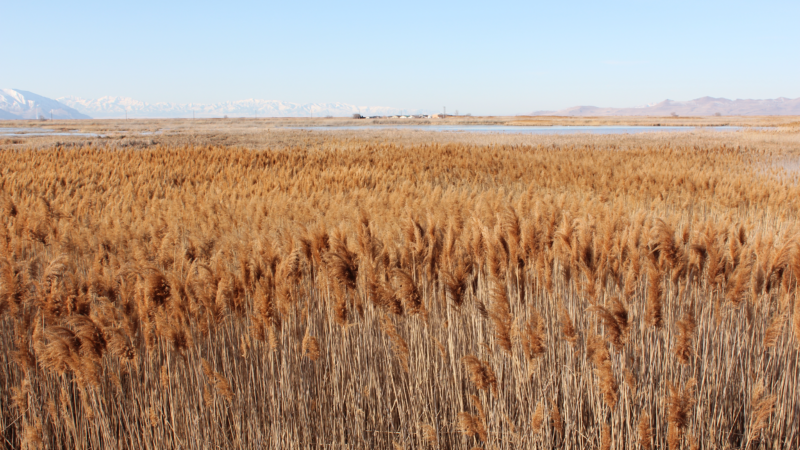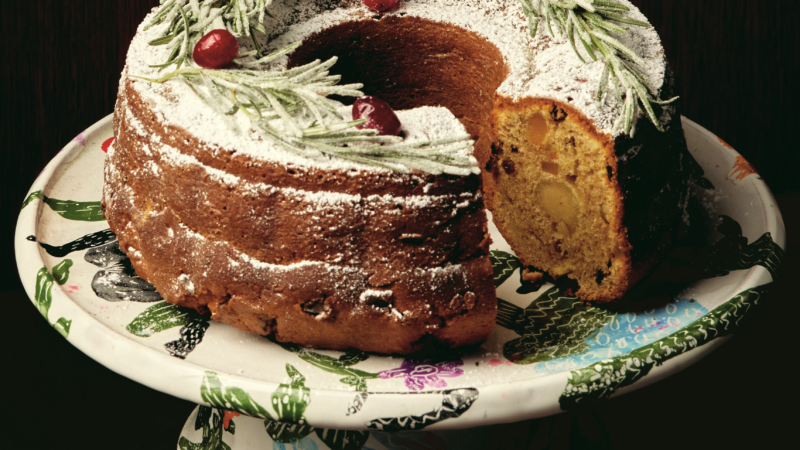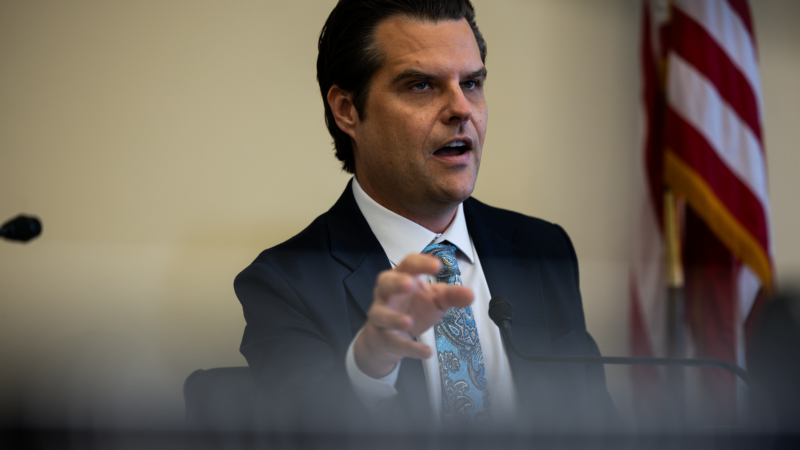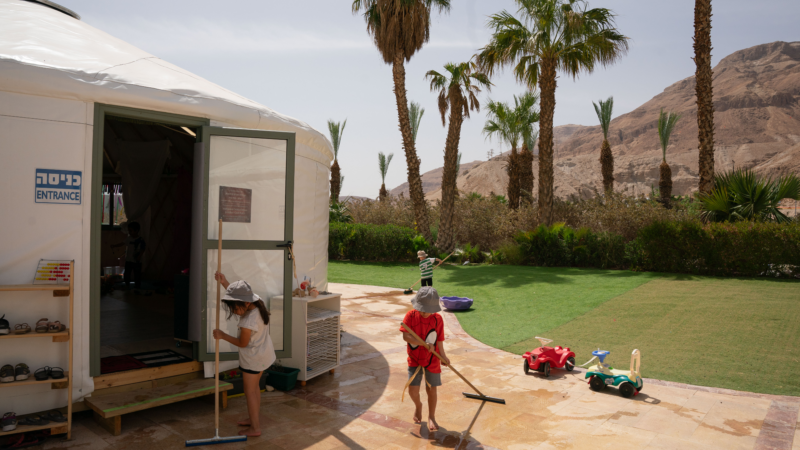You might beat back phragmites, the scourge of wetlands, but then what?
Keith Hambrecht vividly recalls his first experience with the bane of American wetlands, a tall, dense reed called phragmites.
“I didn’t know what it was at the time,” he says, remembering working on a small conservation crew in Utah about a decade ago. They were instructed to go to a pond and pull this invasive weed out by hand, a plan that he now calls “comical.”
“We spent maybe five minutes trying to pull a few stems of phragmites out of the ground,” says Hambrecht. “It’s basically impossible.”
Now he has a much better idea of the extreme measures it takes to battle this plant.
The trouble is, once the reed is poisoned and mowed down, what’s left is a blank slate of mud—the perfect environment for phragmites to come right back.
That’s why ecologists in Utah are trying to figure out how to get native plants growing there quickly, to prevent phragmites from taking hold once again.
“It’s a pretty new endeavor in many wetland systems and the methods are not tried and true,” says Karin Kettenring, a wetlands ecologist with Utah State University.
But there’s one spot next to the Great Salt Lake that gives her hope. There, her research team has experimental plots that have shown how mixes of native seeds can restore a wetland after phragmites has been wiped out.
“For the first time, we were seeing a much higher diversity of native species reestablishing,” she says. “We literally had not ever achieved that before.”
A risky packing material
Puffy-topped phragmites has been around North America for more than a century. It likely got introduced to the east coast as a kind of packing material, with the fluffy seed heads used like Styrofoam in shipping, says Kettenring.
“It didn’t get out to Utah, or at least didn’t explode in Utah, until the early nineties,” she says.
Now, tens of thousands of acres in this state are covered by this reed. Its giant stems can grow over twelve feet tall, in thick, impenetrable bunches that crowd everything else out. And its dense root systems go deep into the wet ground.
“Just how the water is flowing over the land is significantly altered by this plant. That’s just completely different from anything that was here beforehand,” says Hambrecht, noting it can choke up canals and block the flow of rivers. “It has pretty far reaching impacts.”
Utah is just one story. This plant has become a major problem in wetlands across the United States, where it dominates areas that should be filled with a diverse array of native plants that fill the needs of insects and animals such as migrating birds.

To get rid of phragmites, land managers like Hambrecht, who works for the Utah Division of Forestry, Fire, & State Lands, have to spray herbicide over thousands of acres. After that, the massive amount of dead plant material has to be chopped up or burned.
Once areas are treated, however, native wetlands plants don’t just naturally spring back. Given how much it would cost in labor and time to try to put in mature native plants, says Hambrecht, spreading seeds seems to offer the only feasible option.
Getting seeds to take hold is hard, in part because of changeable water levels.
“You would think with a wetland, and water being the defining feature, that you can plan to have consistent water,” says Hailey Machnikowski, a graduate student in Kettenring’s lab. “We find that that’s not the case.”

Mixing up seeds
Machnikowski is standing in a kind of wet meadow at the Howard Slough Waterfowl Management Area. This vast marsh has channels of water crisscrossed by dikes with roads on top.
To get to their experimental plots, the researchers have to put on waders and cross a channel of water, then muck through mud.
This is where they’ve strewn seeds from a carefully chosen mix of nearly two dozen different native species. They included everything from drought-tolerant plants to ones that like to have their feet wet, “basically hoping that something within that mix is going to match what the conditions are,” explains Machnikowski.
“Every two weeks, we come out here and we do visual estimations of cover by species,” says graduate student Montana Horchler, who has been testing the effect of putting out seeds multiple times a year, rather than just once in the spring.
Some seeds they’ve tried have been a bust. Others are doing surprisingly well, like a native plant called pickleweed and a type of beggartick that has bright yellow flowers.
“We’re trying and slowly but surely, we’re learning things one bit at a time,” says Sam Kurkowski, the manager of Kettenring’s lab.
If the lessons they learn are going to be applied on a larger scale, however, somehow they’ll have to get ahold of a lot of seed that normally isn’t found in a store.
For their test plots, they gathered seed by hand from wild plants—a laborious process. Ideally, they’d be able to get native plant seed companies to supply the seeds, but that’s something that still needs to be worked out.
“We just had a big collaborative meeting this fall with native plant vendors and wetland managers to kind of share our experiences and help facilitate working together,” says Hambrecht.
A lot of the native seed providers are “are smaller businesses and they don’t have a big profit margin,” says Kettenring. That means they may not be able to take the financial risk of producing a lot of uncommonly requested seeds unless they know for sure that they’ll have a buyer.
In thinking through all of these challenges, Hambrecht says the collaboration between land managers and the researchers has been invaluable.
“I hope that it can serve as an example for other issues like this,” he says. “I think people look at large invasive species problems and feel like they’re completely futile. But really, we just need to find solutions to a lot of the challenges and then work together in a strategic long-term plan to restore these ecosystems.”
Bill Clinton is hospitalized with a fever but in good spirits, spokesperson says
The 78-year-old former president was hospitalized "for testing and observation" after developing a fever, his deputy chief of staff said in a statement.
Walmart illegally opened delivery drivers’ deposit accounts, U.S. says
Lawsuit alleges Walmart and the payments platform Branch Messenger cost delivery drivers millions of dollars in fees, opening deposit accounts without consent and requiring their use to get paid.
Forget what you think you know about fruitcake
For generations of Americans, making fun of fruitcake has been a holiday tradition. But a Canadian pastry chef and master food preserver would like us to reconsider our assumptions.
The Container Store files for bankruptcy, vows to keep stores operating as normal
The Container Store said its 102 locations and website will continue to operate as normal during the bankruptcy process.
House panel releases report on sexual misconduct allegations against Matt Gaetz
The move is a reversal for the committee, which deadlocked on the issue last month.
How an Israeli community helped its children heal from trauma after the Oct. 7 attack
Kibbutz Be'eri was hit hard in the Hamas-led attack of Oct. 7, 2023. Survivors were evacuated to a hotel, where they worked together to create programs to help their children recover from trauma.







